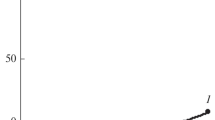Abstract
Microcrystalline anatase titanium(IV) oxide (TiO2) particles were synthesized by hydrothermal crystallization in organic media (HyCOM) followed by calcination, and used in a photocatalytic reaction system of silver metal deposition. Upon elevating the post-calcination temperature, the photocatalytic activity was enhanced in spite of the simultaneous decrease in amount of surface-adsorbed Ag+. Comparison with the effect of calcination temperature on the other reaction systems revealed that the annealing effect became more significant with increasing number of electrons (or holes) required to complete the photocatalytic reaction process.
Similar content being viewed by others
Author information
Authors and Affiliations
Rights and permissions
About this article
Cite this article
Kominami, H., Murakami, Sy., Kera, Y. et al. Titanium(IV) oxide photocatalyst of ultra-high activity: a new preparation process allowing compatibility of high adsorptivity and low electron–hole recombination probability. Catalysis Letters 56, 125–129 (1998). https://doi.org/10.1023/A:1019052911437
Issue Date:
DOI: https://doi.org/10.1023/A:1019052911437



